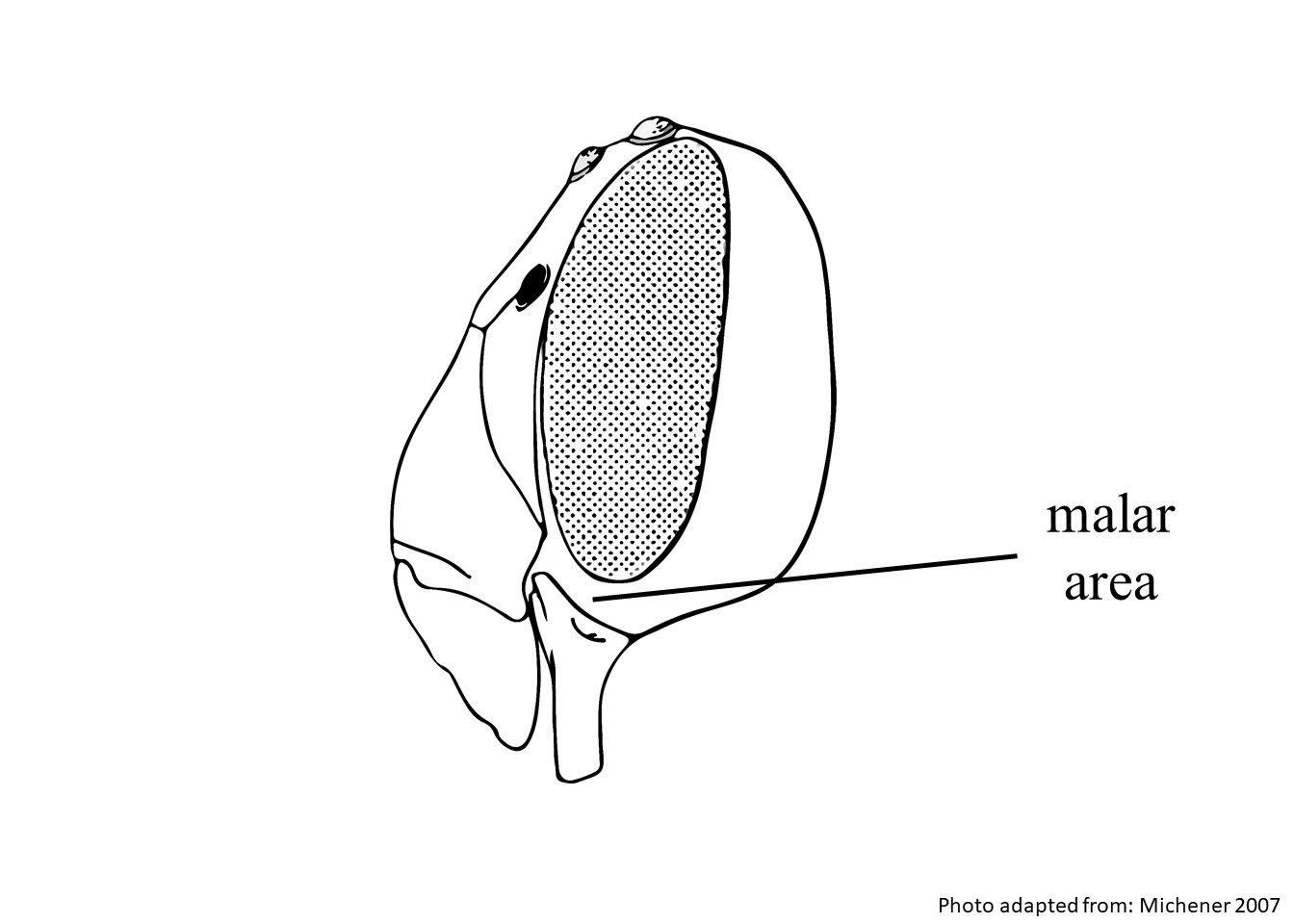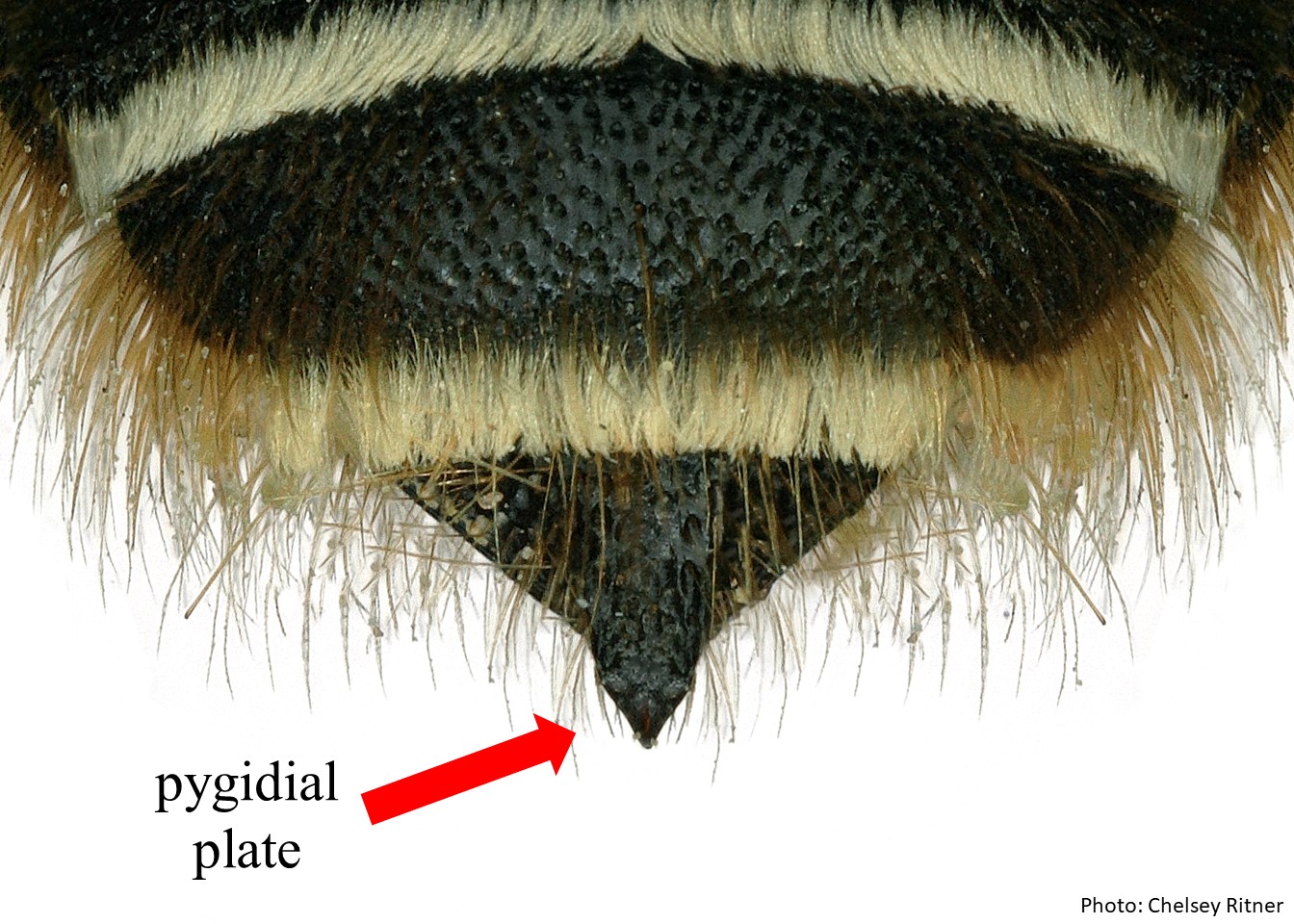Xylocopa (Mesotrichia) are very large bees, 25 – 36 mm in length, with shiny black integumentintegument:
a tough, protective outer layer
, sometimes with pale maculations on their face and legs. They have moderately dense black pubescencepubescence:
short, fine hair
through much of their body but often have pale pubescencepubescence:
short, fine hair
on the head, thorax, and last tergaterga:
the segments on the top side of the abdomen, often abbreviated when referring to a specific segment to T1, T2, T3, T4, T5, T6, or T7 . The wings are often dark brown with blue or green iridescence (Hurd and Moure 1963Hurd and Moure 1963:
. The wings are often dark brown with blue or green iridescence (Hurd and Moure 1963Hurd and Moure 1963:
Hurd, P.D. and J.S. Moure. 1963. A Classification of the Large Carpenter Bees (Xylocopine) (Hymenoptera: Apoidea). University of California Publications in Entomology (Vol. 29). Berkeley and Los Angeles: University of California Press, 365 pp.).
Xylocopa (Mesotrichia) has 23 listed species (Michener 2007Michener 2007:
Michener, C.D. 2007. The Bees of the World (2nd ed.). Johns Hopkins University Press, Baltimore and London, 953 pp.; Mawdsley 2017Mawdsley 2017:
Mawdsley, J. R. 2017. Taxonomy of the African large carpenter bees of the genus Xylocopa Latreille, 1802, subgenus Xenoxylocopa Hurd amp; Moure, 1963 ( Hymenoptera , Apidae ). Zookeys (655): 131-139.).
Members of Xylocopa (Mesotrichia) can be found across sub-Saharan Africa, up to Iran, and east through India into Southeast Asia, and into Indonesia and the Philippines (Michener 2007Michener 2007:
Michener, C.D. 2007. The Bees of the World (2nd ed.). Johns Hopkins University Press, Baltimore and London, 953 pp.).

Distribution map generated by Discover Life -- click on map for details, credits, and terms of use.
Xylocopa (Mesotrichia) has been observed pollinating almost exclusively flowers of the Leguminosae family, including but not limited to the genera of Aspalathus, Podalyria, Psoralea, and Virgilia. These plants tend to bloom in the late spring and early summer (Skaife 1952Skaife 1952:
Skaife, S. H. 1952. The Yellow-banded Carpenter Bee, Mesotrichia caffra Linn, and its Symbiotic Mite, Dinogamasus Braunsi Vitzthun. Journal of the Entomological Society of Southern Africa 15(1): 63-76.; Pasquet et al. 2008Pasquet et al. 2008:
Pasquet, R. S., A. Peltier, M. B. Hufford, E. Oudin, J. Saulnier, L. Paul, J. T. Knudsen, H. R. Herren, and P. Gepts. 2008. Long-distance pollen flow assessment through evaluation of pollinator foraging range suggests transgene escape distances. National Academy of Sciences 105 (36): 13456-13461.). Xylocopa (Mesotrichia) tenuiscapa is known be the sole pollinator of Heterophragma quadriloculare and only pollinates this tree at night (Somanathan and Borges 2001Somanathan and Borges 2001:
Somanathan, H. and R. M. Borges. 2001. Nocturnal Pollination by the Carpenter Bee Xylocopa tenuiscapa (Apidae) and the Effect of Floral Display on Fruit Set of Heterophragma quadriloculare (Bignoniaceae) in India. Biotropica 33(1): 78-89.).
(modified from Hurd and Moure 1963Hurd and Moure 1963:
Hurd, P.D. and J.S. Moure. 1963. A Classification of the Large Carpenter Bees (Xylocopine) (Hymenoptera: Apoidea). University of California Publications in Entomology (Vol. 29). Berkeley and Los Angeles: University of California Press, 365 pp. and Michener 2007Michener 2007:
Michener, C.D. 2007. The Bees of the World (2nd ed.). Johns Hopkins University Press, Baltimore and London, 953 pp.)
 short.
short. narrow, parallel-sided, and without subapicalsubapical:
narrow, parallel-sided, and without subapicalsubapical:Xylocopa (Mesotrichia) are similar to X. (Koptortosoma) because they both have a sharply angled transverse truncation on their scutellumscutellum:
shield shaped plate behind scutum. Male X. (Mesotrichia) can be distinguished by their more elongate tegulategula:
the usually oval, small shield-like structure carried at the extreme base of the wing where it attaches to the body that are impunctateimpunctate:
marked with punctures or pits
in the posterolateral third. Females can be distinguished by the distinct, deep pits behind the laterallateral:
relating, pertaining, or attached to the side
ocelli (Hurd and Moure 1963Hurd and Moure 1963:
Hurd, P.D. and J.S. Moure. 1963. A Classification of the Large Carpenter Bees (Xylocopine) (Hymenoptera: Apoidea). University of California Publications in Entomology (Vol. 29). Berkeley and Los Angeles: University of California Press, 365 pp.).
Most members Xylocopa (Mesotrichia) nest in dead branches, stumps, and logs that have been slightly softened by decay. They have also been known to nest in the dry stalks of Agave and Aloe and in old fence posts (Skaife 1952Skaife 1952:
Skaife, S. H. 1952. The Yellow-banded Carpenter Bee, Mesotrichia caffra Linn, and its Symbiotic Mite, Dinogamasus Braunsi Vitzthun. Journal of the Entomological Society of Southern Africa 15(1): 63-76.).
There are no known invasives.
Hurd, P.D. and J.S. Moure. 1963. A Classification of the Large Carpenter Bees (Xylocopine) (Hymenoptera: Apoidea). University of California Publications in Entomology. Berkeley and Los Angeles: University of California Press 29: 365 pp.
Mawdsley, J. R. 2017. Taxonomy of the African large carpenter bees of the genus Xylocopa Latreille, 1802, subgenus Xenoxylocopa Hurd & Moure, 1963 (Hymenoptera, Apidae). Zookeys (655): 131-139.
Michener, C.D. 2007. The Bees of the World (2nd ed.). Johns Hopkins University Press, Baltimore and London, 953 pp.
Pasquet, R. S., A. Peltier, M. B. Hufford, E. Oudin, J. Saulnier, L. Paul, J. T. Knudsen, H. R. Herren, and P. Gepts. 2008. Long-distance pollen flow assessment through evaluation of pollinator foraging range suggests transgene escape distances. National Academy of Sciences 105 (36): 13456-13461.
Skaife, S. H. 1952. The Yellow-banded Carpenter Bee, Mesotrichia caffra Linn, and its Symbiotic Mite, Dinogamasus Braunsi Vitzthun. Journal of the Entomological Society of Southern Africa 15(1): 63-76.
Somanathan, H. and R. M. Borges. 2001. Nocturnal Pollination by the Carpenter Bee Xylocopa tenuiscapa (Apidae) and the Effect of Floral Display on Fruit Set of Heterophragma quadriloculare (Bignoniaceae) in India. Biotropica 33(1): 78-89.